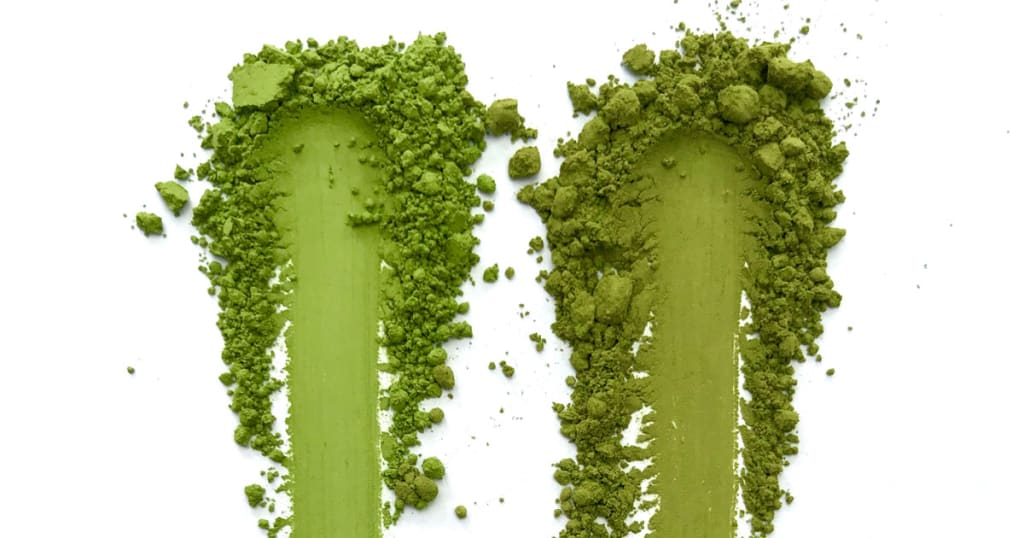Avoid these 5 costly Matcha buying mistakes
How to spot the difference between good matcha and bad matcha

I've lost count of the number of times that I've heard someone say they've tried matcha and couldn't stand the taste.
Why does matcha taste fishy, why is it so grassy.... Wow, why does matcha tea taste so bitter!
Here's the thing. Matcha is not supposed to taste bad... It's supposed to taste AMAZING!
Time and time again, people read all about the amazing health benefits of matcha and want to try it out and the first thing they do is go to the supermarket and buy the cheapest green tea powder they can find and expect the best.
I'm sorry, but they are going to be met with bitter disappointment.
Just like bad wine versus a good wine. Matcha comes in a variety of grades that mark its true quality.
Often referred to as macha - Genuine, authentic matcha - a ceremonial grade matcha - is extremely difficult to produce.
To make my point clear, I purchased a $25 everyday matcha from my local grocery store and compared it to our EISAI Ceremonial grade Uji Matcha powder.
As expected, the results were profoundly different in every way including - smell, texture, colour, liquid and most importantly TASTE!
Mistake 1 - Didn't check the expiry date
Check the use by date / expiry date.
Just like buying milk from the grocery store. Always check the use by date.
If the expiry date is due in a few weeks then chances are that the matcha was packaged almost 12 months ago!
You never pick the milk from the front row right?
Always buy matcha that has close to a 12 month lead time until expiry date.
At Purematcha, we only order in small quantities meaning that most of the time the Matcha you buy from us will have 12 - 9 months lead time before the expiry date. Super fresh!
Mistake 2 - Didn't check the country of origin
Matcha originated from China, however, it was the Japanese that perfected the cultivating and manufacturing process.
Soil contamination is a big factor in developing countries such as China.
Today, Japan is among the world’s least polluted, according to the World Health Organisation.
Japan has some of the strictest farming standards and practices in the world. This ensures that the soil is extremely clean which produces matcha that is free of heavy metals
Mistake 3 - Bought matcha that is too coarse
Low grade matcha is usually coarse made up of large particles making it difficult to dissolve in water.
Why is low grade matcha coarse?
It is probably because the leaves skipped the crucial step of de-stemming and de-vining prior to milling.
Another factor is how the leaves are broken down into a powder form.
Some manufacturers use jet mills which produces matcha powder at a much faster rate, however, at a much higher temperature.
This significantly reduces the matcha aroma and flavour, and increases its bitterness.
The highest grades of matcha are superfine with very small particles and feels more like baby powder when you rub it between your fingers.
Matcha that is slowly ground from stone mills will typically produce only 30-40 grams of matcha per hour. Stone milling delivers the best tasting result as the matcha is not affected by heat.
Both our EISAI ceremonial matcha and KOZAN-JI culinary matcha are milled using traditional granite stone mills.
Mistake 4 - Bought matcha that has a yellowish-green colour
Chlorophyll is what gives matcha its vibrant green colour
Premium grade matcha is shade grown for up to 4 weeks before harvest.
Bamboo tarps shading the tea leaves inhibit the photosynthesis process.This shading causes the plants to concentrate large amounts of chlorophyll and other nutrients in the leaves.
If your matcha is green with a yellow tint, it usually means that most of the leaves came from the second pickings (older mature leaves) therefore a lower grade of matcha.
Bright green matcha means that the leaves were picked during the first harvest (First flush) and are younger and have a higher concentration of Chlorophyll and L-thanine.
Mistake 5 - Bought matcha that hasn't been tested for radiation
On March 11 2011, there was an energy accident at the Fukushima Nuclear Power Plant, initiated by a tsunami.
Since that time, the Japanese government has been testing samples of tea on a regular basis.
Teas from western Japan regions of Uji, Kyoto, and Kyushu Island were never found to contain radiation.
Despite that fact, always check to see if the importer has run any radiation detection tests on Matcha.
At Purematcha, the safety of our products is our number 1 concern. As a result our teas are tested at the farm and also randomly tested by independent laboratories in Australia.
About the Creator
Purematcha
We are an Australian importer of the finest Japanese green teas and teaware.






Comments
There are no comments for this story
Be the first to respond and start the conversation.